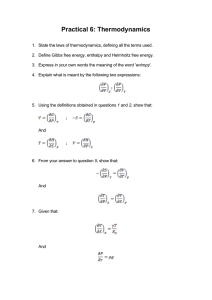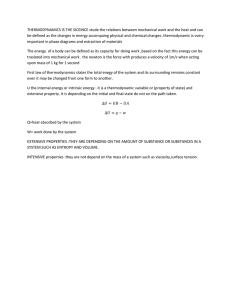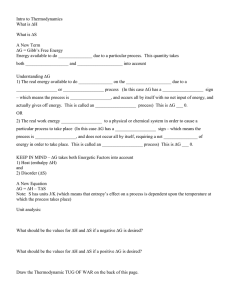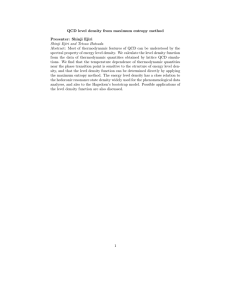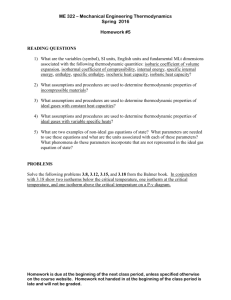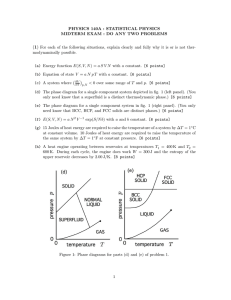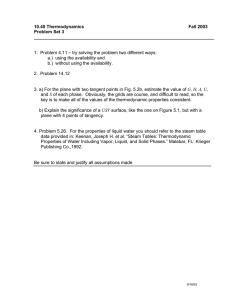Lecture 1
advertisement
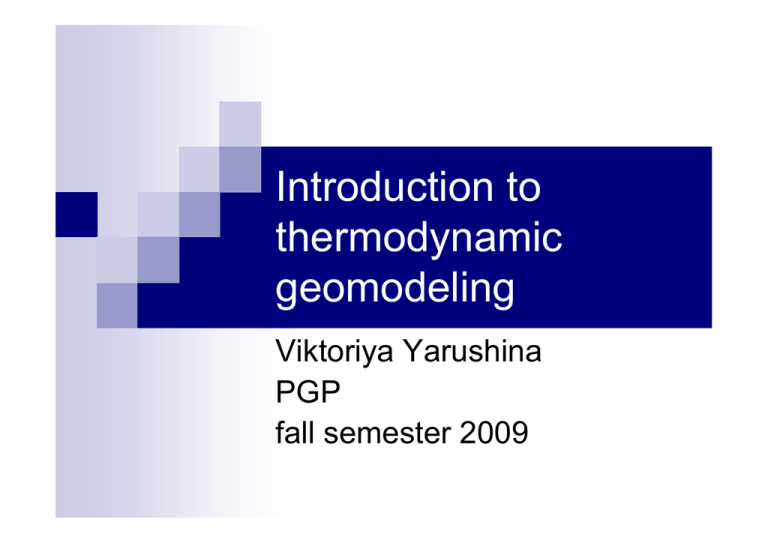
Introduction to thermodynamic geomodeling Viktoriya Yarushina PGP fall semester 2009 Thermodynamic system – system in thermodynamic equilibrium, i.e. all parameters are const in time, d/dt = 0, d/dx = 0, no fluxes Open system: matter and energy exchange Closed system: energy exchenge Isolated system: no exchange Nonequilibrium system – d/dt ≠ 0 or d/dx ≠ 0 Σ m, V Σ m, V Homogeneous system – f(x) – continuous Gas mixtures Liquid and solid solutions Heterogeneous system f(x) – discontinuous Partially molten rock Melting ice Oil-gas mixture 3 Phase - Component Σ13 ρ3, T3 Σ12 ρ2, T2 ρ1, T1 Component is a chemically distinct constituent of a system. Their concentrations may be varied independently in the various phases. Internal – External parameters x, v ρ, p, V, e but x2 v V p = const p - external p V = const V - external t2 t1 x1 Thermodynamic parameters (internal) Extensive Intensive Mass Volume Energy V1 + V2 = V1+V2 Temperature Density Pressure T1 + T2 ? = T1+T2 Energy What is the energy? Energy Kinetic Potential Internal E = K + Epot + U System as a whole, K = mv2 In external force fields, Epot = mgh Everything else, U = U(ai,T), ai – external parameters Thermodynamics deals only with internal energy with some exceptions Work One of the means of energy exchange when external parameters change W = ∫F ds dW is not a perfect differential ∫dW depends on the path W is not a state variable dW = -p dV dW = V0∑σikdeik B A dW ≠ WB-WA Heat One of the means of energy exchange when external parameters DO NOT change B 1 dQ is not a perfect differential ∫dQ depends on the path Q is not a state variable 2 A dQ ≠ QB-QA The First Law or Energy Balance For isolated systems: dE = 0 For closed systems: dU = dQ + dW B For open systems: ? dU = dQ + ∑Aidai ai – external parameters Ai – conjugate forces A dU=UB-UA U is perfect differential Perpetuum mobile of the 1st kind is impossible: any device which indefinitely produces the work without consuming the energy is forbidden The Second Law or Entropy and absolute temperature ∫dQ/T = dS = SB-SA B Entropy S is a state variable T is thermodynamic (absolute) temperature (K) dQ = TdS dS≥0 A dS=SB-SA No process is possible whose sole effect is to transfer heat from cold body to a hot body Perpetuum mobile of the 2nd kind is impossible: An engine that produces work by extracting heat from its surroundings is impossible Entropy S = S1+S2 What is the entropy? Gibb’s equation dU = dW + dQ + dQ = ? dW = ? = ? Matter exchange – open systems Variations in composition – chemical reactions dU = dW + dQ + dQ = ? dW = ? = ? Thermodynamic processes Isothermal: T = const, dU = -pdV + TdS Isochoric: V = const, dU = -pdV + TdS Isobaric: p = const, dU = -pdV + TdS Adiabatic: Q = const, dU = -pdV + TdS Thermodynamic potentials Gibbs energy G = U – TS: U=U(Ai,T) Enthalpy H = U + pV: U=U(Ai,S) Helmholtz energy F = U – TS: U=U(ai,T)
